
Rare gold and silver Chinese coins are deservedly in demand among collectors around the world. This category of monetary units practically does not occur in the public domain, so the cost of coins is much higher. The rare ones include coins with outdated design, manufacturing defects, special issues of commemorative samples, as well as investment series with a small issue.
History
The first money appeared on the territory of ancient China about 3,000 years ago. At first, the inhabitants of the Celestial Empire used cowry shells for trade, then coins of various forms (hoe, knife, shoulder blade and ring), as well as cloth, grains and precious stones came into use. Beginning in the 5th century, coins became more popular. More often they were made of bronze, copper or iron, less often of gold and silver. At that time precious metals were very rare, therefore gold and silver bars were used only for large transactions.
Did you know? Recently in China, the Guardian auctioned the largest gold coin ever minted in this country (one out of 20). In 2000, it was considered the largest in the world. On May 14, 2011, the coin was sold at a price of about 1.18 million $ USD. Her face value was 30,000 yuan, weight − 10 kilograms, the sample − 99.99% pure gold. The modern record holder is the Canadian “Maple Leaf”. The weight of the coin is 100 kg, diameter − 50 cm, thickness − 3 cm.
Ancient coins of precious metals is a rarity. Until the 20th century, silver was used for coinage, and gold in the form of coins never participated in the circulation of money in China. Only after the overthrow of the Qing dynasty (1912) began the release of gold coins of 5, 10 and 20 $ USD with portraits of Chinese leaders. These copies did not fall into the cash flow. Their appointment was a memorial − distribution in the form of awards.
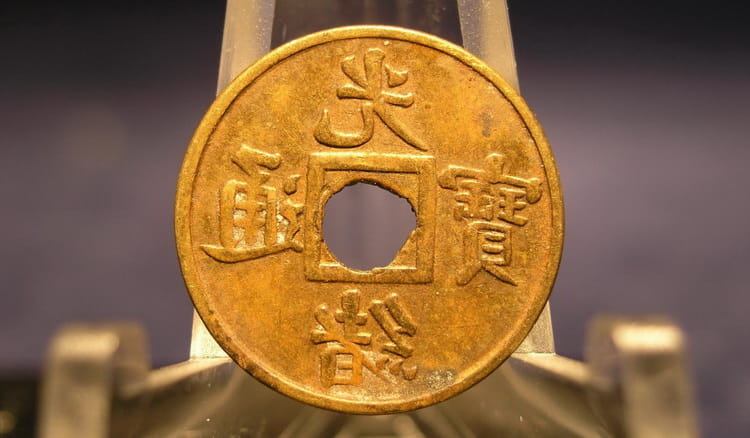
A small number of coins made of precious metals has come down to us since the power in China has changed quite often. With each new ruler, coins were withdrawn from the population and melted down. The Chinese themselves preferred to use non-ferrous coins for trading, and later − paper money. Also, the inhabitants of the Middle Kingdom melted coins into bars, preferring to keep precious metals in this form.
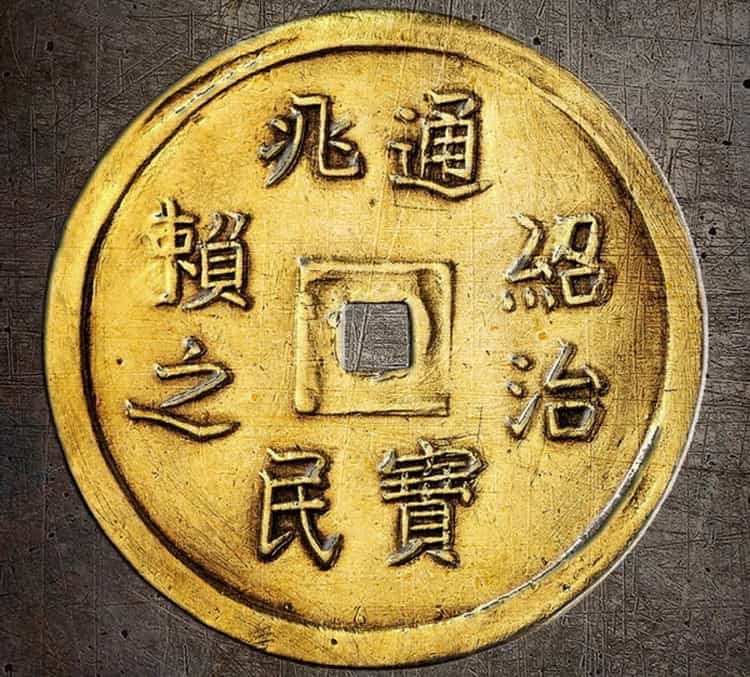
The first gold coins found in southern China (205 BC. E. – 900 g. E.) had a rectangular shape that looked more like bullion. The coins were called “yuan”, which in translation meant “ingot”. Only hieroglyphs were depicted on their surface − the first Chinese coins made of gold did not carry a certain meaning and did not differ in exquisite patterns. Their weight ranged from 8.21 to 17.53 g.
Did you know? Lu Xun (1881-1936) is one of the greatest Chinese writers of the 20th century and the founder of modern Chinese literature. But few people know about his contribution to Chinese numismatics. The writer was a passionate collector of ancient Chinese coins and the author of a manuscript annotated with Chinese coins from the 7th to the 17th centuries. The manuscript was written in 1913, when Lu Xun worked at the Ministry of Education in Beijing. At that time, he began studying ancient books about Chinese coins and often visited Lyulichan Street to replenish his collection. He cataloged 1,311 coins, from the Tang dynasty to the Song dynasty.
The production of coins made of precious metals in China belonged to the kingdoms:
- Shu (221-265)
- U (222-280)
- Southern Liang (502-556)
- Northern Qi (550-577)
- Northern Zhou (557-581)
After the appearance of the first paper money (960-1127), the time of the Northern Song dynasty, the gold and silver coins began to be produced only for special events. The first copies were more like medals than a means for trading (the portrait of the ruler was depicted on the obverse). Until 1189, banknotes caused mistrust as a monetary unit, not supported by state guarantees. In 1200, paper money was replaced with coins of silver, but even this step did not help to cope with inflation (most of the old samples were again melted down by the Chinese population).
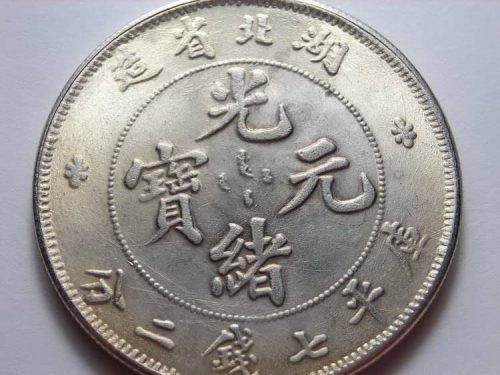
During the reign of the Song Dynasty, the first drawings and calligraphic signatures with beauty and refinement appear on the surface of gold and silver coins. On the front side you can see the image of dragons, horses and fantastic animals. This feature suggests that in China begins the heyday of coin production. Figures are accompanied by information on the year of issue and the region.
Did you know? The earliest gold coins in ancient China were found in the south of the country − in the kingdom of Chu. On the surface there was a stamped inscription “Ying Cheng”. Ying (Ying) − the name of the capital of the kingdom of Chu, and Cheng (Cheng) was read as Yuan (metric unit of weight and the name of money).
After the Mongol tribes conquered the Chinese state, the next 300 years they used only bronze for the production of coins. In 1693, silver bars were issued − “Liang”. The weight of the ingot was approximately 36 g. It was used to pay tax duties until 1933. In 1835, the first circulation of silver coins “Yuan” was released. The cost of one coin was equal to 0.72 Liang. At times, minted coins weighing 1 Liang (37 grams).
In 1889, a new monetary standard for China appeared:
- 1 yuan − 10 zao
- 1 Zao − 10 Fen
- 1 fen − 10 wen
In contrast to the European production of coins, the Chinese masters cast coins, not minted them. For each instance, two forms were used − pressed sand slabs. Metal was poured into one, the other was covered and coated with clay to avoid displacement. On the surface indicated the weight, face value and place of casting.
Since 1979, China has been developing the program of issuing investment and commemorative coins made of precious metals. The first smallest print run belongs to the rare and highly desired series “Year of the Child”. A total of 2,000 coins of gold and 500 of silver were issued. At auctions, these coins are sold for 143,000 $ USD.
Rare Chinese coins of gold and silver from 1979 to the present day:
- 500 yuan of gold as a proof of 1993
- 500 yuan from the 1993 Marco Polo gold series
- 20 yuan of the Chinese Golden Panda series 1995
- 50 yuan from silver in honor of 2012 Zhong Kui.
The first series of investment Chinese coins of the “Panda” series made of gold and silver belong to rare specimens, since their circulation was only 10-20 thousand. Due to the limited release, the value of these coins is made up of the value of the precious metal and the numismatic value.
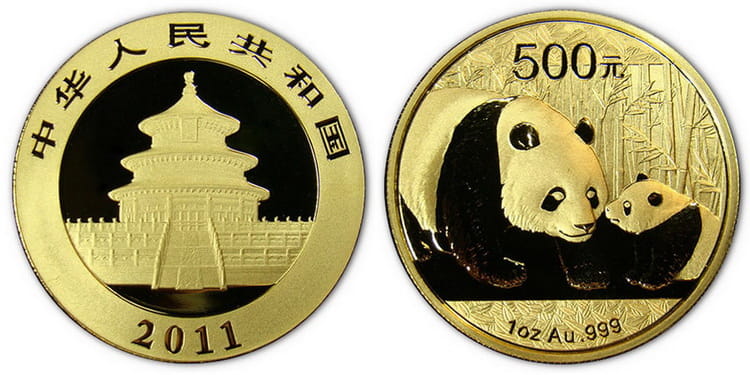
Design
The drawings on ancient coins make it possible to trace how the chased art of China developed. If the oldest samples do not have signatures, then in later instances there are abstract inscriptions (ancient Chinese characters) and images (dragon, unicorn, phoenix). Modern rare coins of gold and silver (commemorative and investment) were minted in as Proof manually.
Did you know? One of the most recognizable coins in the world of numismatics is the silver dollar with the profile of Sun Yat-sen (the Chinese revolutionary and creator of the Guomindang party) on the front side and the inscription “Memento Birth of Republic of China” on the reverse. An earlier version of the coin was issued in 1912 in honor of the creation of the Republic of China. But production ceased when Yuan Shikai became president in 1913.
The design of coins made of precious metals has noticeably improved over time. In the Tang era, the reverse was decorated with an inscription of 4 hieroglyphs “nianhao” − the motto of the ruling dynasty, and obverse − 2 hieroglyphs (abbreviated “nianhao” and year of release). Years later, graphic art (calligraphy) in China was greatly developed. During the Song period, italic handwriting and first images appeared on the surface.
After the Xinhai Revolution of 1911 and the subsequent collapse of the empire, portrait coins of precious metals appeared in China. Rare specimens with a nominal value of 1 dollar contained a portrait of General Yuan Shikai, the Emperor Guangxu and the revolutionary Sun Yat-sen. The most expensive coin of that period – 50 $ USD in 1927 with a portrait of Zhan Zuo Lin was sold at auction for 500,000 $ USD.
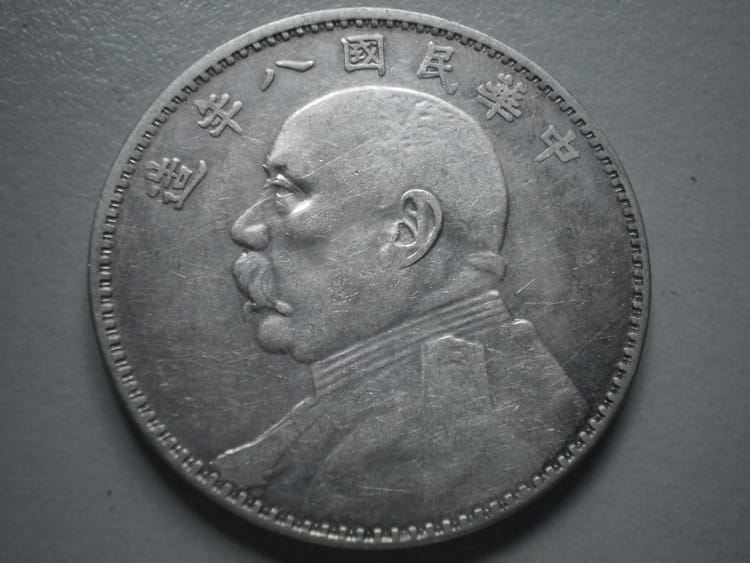
In 1982, the first coins appeared as a Proof in gold, and in 1983 − in silver. Popular, but rare (circulation was 20,000 copies) with the image of the national animal − the panda in its natural habitat. “Panda” series investors and collectors liked it so much that each subsequent year (except 2001-2002) they released a new design edition. Coins immediately went to the collections. The cost of the first “Pandas” comes to 4,000 $ USD.
Circulation
China’s pre-revolutionary coins made of gold and silver are quite rare – casting coins was quite a long and expensive process. To this day, no more than 10-15 copies, created before 1911, have survived. Most are kept in museums. From 1911 to 1979, the circulation of jubilee and commemorative coins increased to 5,000-10,000, and starting in 1979, precious samples produced at least 10,000-20,000 pieces.
Cost of coins
The cost of rare coins of gold and silver of China varies from circulation and demand. Gold coins as XF 1906 at auction cost 200-300 $ USD, and as AU − 400-600 $ USD. Silver copies of the revolutionary period cost from 400 to 1,000 $ USD. In 2015, the Khan-Sin silver dollar was auctioned at 1,300 $ USD.
The price of modern commemorative coins (1982-1995) made of gold reaches 1500-4000 $ USD (“Panda” with a denomination of 100 yuan), for silver copies it ranges from 150 to 300 $ USD.
Comments
No commens yet.